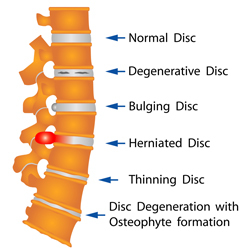 Discs are soft, rubbery pads found between the hard bones or vertebrae of the spinal column. They are composed of a thick ring of cartilage (annulus) with a nucleus made of a gel-like substance. Discs in the neck are the same composition, but smaller. Discs allow the back to flex or bend and act as shock absorbers.
Discs are soft, rubbery pads found between the hard bones or vertebrae of the spinal column. They are composed of a thick ring of cartilage (annulus) with a nucleus made of a gel-like substance. Discs in the neck are the same composition, but smaller. Discs allow the back to flex or bend and act as shock absorbers.
A herniated disc is a common source of back or neck pain. A disc herniates or ruptures when part of the gel in the nucleus pushes through the outer edge of the disc and back toward the spinal canal, putting pressure on sensitive nerves. Herniated discs in the back can result in pain, numbness or weakness in one or both legs. A herniated disc can cause sciatica in the lower back, a painful condition that radiates down the leg and may impair movement.
When a disc herniates in the neck, it puts pressure on the nerve and causes pain in the muscles between the neck and shoulder (trapezius muscles) and may shoot down the arm. Symptoms include burning pain in the neck, shoulder or arm and weakness or numbness in the arm.
In children and young adults, discs have high water content. As people age, the water content in the discs decreases and the discs become less flexible. The discs begin to shrink and the spaces between the vertebrae get narrower. Conditions that can weaken the disc include improper lifting, smoking, excess weight, and strenuous work or sports activities.
To determine whether a DOC guest has a herniated disc, the orthopedist will discuss medical history. A physical examination helps to determine which nerve roots are affected and an MRI scan provides clear images of soft tissues like discs to confirm a diagnosis of a herniated disc.
Nonsurgical treatment is effective in treating the symptoms of herniated discs for most guests, including rest, anti-inflammatory medications and cold compresses. Gentle exercises and proper posture strengthen the back muscles and may help to avoid future episodes.
If nonsurgical treatment fails, epidural injections of a cortisone-like drug may lessen nerve irritation and allow more effective participation in DOC physical therapy. Only a small percentage of patients with disc herniations require surgery. Discuss options with the DOC orthopedic spine surgeon.
To learn more about neck and spine conditions treated by DOC, please visit our services page:


